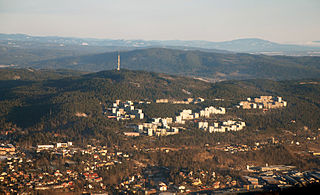
Grorud is a borough of the city of Oslo, Norway. The borough contains the Ammerud, Grorud, Kalbakken, Rødtvet, Nordtvet and Romsås areas. To the north of the borough is the forest of Lillomarka. The borough is the smallest in Oslo, with fewer than 30 000 inhabitants.

Romsås is a neighborhood in the city of Oslo, Norway. Located northeast of Groruddalen, at the edge of Lillomarka, Romsås was formerly its own borough but was merged into the larger borough of Grorud on January 1, 2004. The name Romsås originated with the Romsås farm which by 1850 was one of the biggest farms in Østre Aker.

The Oslo Metro is the rapid transit system of Oslo, Norway, operated by Sporveien T-banen on contract from the transit authority Ruter. The network consists of five lines that all run through the city centre, with a total length of 85 kilometres (53 mi), serving 101 stations of which 17 are underground or indoors. In addition to serving 14 out of the 15 boroughs of Oslo, two lines run to Kolsås and Østerås, in the neighbouring municipality of Bærum. In 2016, the system had an annual ridership of 118 million.
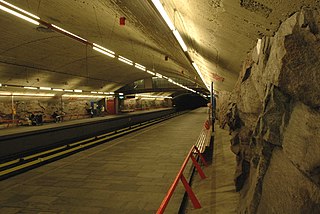
The Grorud Line is a 13.0-kilometer long (8.1 mi) line on the Oslo Metro between Tøyen and Vestli in Oslo, Norway. Built as a mix of underground, at ground level and as an elevated line, it runs through the northern part of Groruddalen, serving such neighborhoods as Grorud, Romsås and Stovner. Line 5 runs along the entire line four times per hour. Line 4 runs between Vestli and Økern before branching off on the Løren Line to get onto the Ring Line. With 40,000 daily riders, the Grorud Line is the busiest branch of the metro.

The Furuset Line is a 5.6-kilometer (3.5 mi) long line on the Oslo Metro between Hellerud and Ellingsrudåsen in Oslo, Norway. Running mostly underground, it passes through the southern part of Groruddalen, serving neighborhoods in the boroughs of Alna and Furuset. The line is served by Line 2 of the metro with four or eight trains per hour. The line is owned by Kollektivtransportproduksjon and operated by Oslo T-banedrift on contract with Ruter using MX3000 trains.
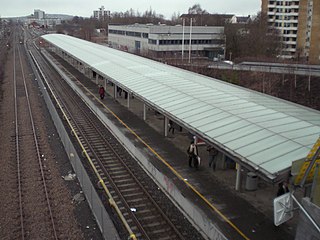
Storo is a rapid transit station on the Ring Line of the Oslo Metro, and a tram station on the Grünerløkka–Torshov Line of the Oslo Tramway. It is located at Storo in the Nordre Aker borough of Oslo, Norway. The tram station opened on 28 November 1902, and the rapid transit station on 20 August 2003. Metro lines 4 and 5 run to the station. The tram station serves lines 11, 12 and 18. The station is within walking distance of Grefsen Station on the Gjøvik Line. The station also functions as a bus hub, being located along Ring 3. Storo is a mixed commercial and residential area, and a shopping center is located just north of the subway station.
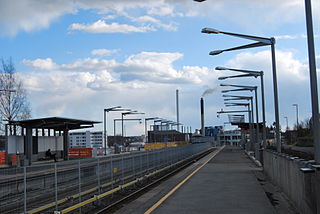
Vollebekk is a station on the Grorud Line of the Oslo Metro. It is located between the stations of Risløkka and Linderud and is 7.1 kilometers (4.4 mi) from Stortinget. The station is among the original ones on Grorudbanen, and opened on 10 October 1966. Peer Qvaam was the station's architect.

The Alna Line is a 4.3-kilometer (2.7 mi) railway line between Alnabru and Grefsen in Oslo, Norway. The single track line allows direct access between the Trunk Line and the Gjøvik Line, without having to pass via Oslo Central Station. The line is electrified and is owned by the Norwegian National Rail Administration. It is exclusively used by freight trains, and allows trains on the Bergen Line to reach Alnabru Freight Terminal.
Rocky Rexhep Lekaj is a professional footballer who plays as a midfielder or left winger for Gjøvik-Lyn. Born in Kosovo, he has represented Norway at an international youth level and formerly played for Sheffield Wednesday.

The Løren Line is a 1.6-kilometer (1.0 mi) line of the Oslo Metro. Located entirely underground, it runs through the neighborhoods of Sinsen, Løren and Økern in Bjerke, creating a connection between the Ring Line with the Grorud Line. The line features one station, Løren. It is served by metro trains which run down the Grorud Line and then connect to the Ring Line. It allows for higher capacity on the metro as more passengers a transported via the Ring Line instead of through the congested Common Tunnel. Construction started in June 2013 and the line opened on 3 April 2016.

Grorud Station is a railway station on the Trunk Line located in the Grorud borough of Oslo, Norway. Situated 10.50 kilometers (6.52 mi) from Oslo Central Station, it consists of three tracks with a side platforms and an island platform. Grorud is served by the L1 line of the Oslo Commuter Rail.
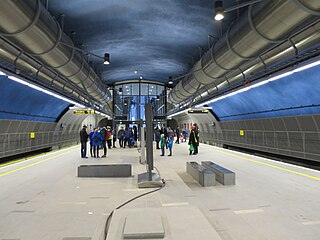
Løren station is an underground rapid transit station of the Oslo Metro and the newest on the subway network. Serving the Oslo, Norway, neighborhood of Løren in the borough of Grünerløkka, the station is the only situated on the Løren Line. Designed by Arne Henriksen, the station is situated 27 meters (89 ft) underground. Construction of the station began in 2013 and was completed in 2016. The station is estimated to have 6,000 daily passengers. It is served every fifteen minutes by trains running along the adjoining Ring Line via the Løren Line to the Grorud Line.

The history of the Oslo Tramway and Oslo Metro in Oslo, Norway, starts in 1875, when Kristiania Sporveisselskab (KSS) opened two horsecar lines through the city centre. In 1894, Kristiania Elektriske Sporvei (KES) built the first electric street tramways, which ran west from the city centre. Within six years, all tramways were electric. The city council established Kristiania Kommunale Sporveie (KKS) in 1899, which built three lines before it was sold to KSS six years later. Both KSS and KES were taken over by the municipality in 1924, becoming Oslo Sporveier. The company gradually expanded the city tram network, which reached its peak length in 1939.
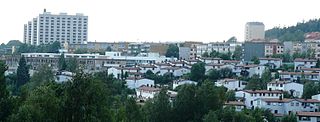
Linderud is a neighborhood in Bjerke borough, Oslo, Norway. The area originally formed part of the estate of Linderud Manor.
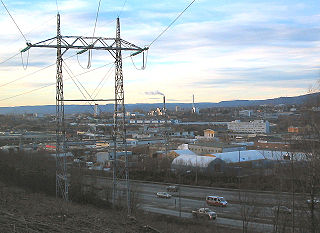
Alnabru is a neighbourhood of north-eastern Oslo. It lies in the middle of the southern part of the Grorud valley (Groruddalen). The name – which means "Alna bridge" – comes from that of the Alna River, from which are also derived the names of the old Alna Gård estate and the borough of Alna, in which Alnabru is located.
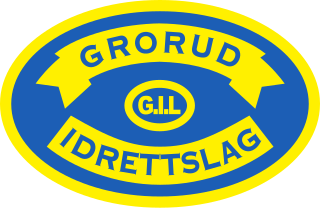
Grorud Idrettslag is a Norwegian sports club from Grorud borough, Oslo. It has sections for association football, skiing, gymnastics and tennis.
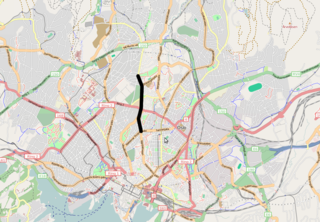
The East End and West End are used as names for the two parts of Oslo, Norway, formed by the economic and socially segregating separation line that has historically passed along the street Uelands gate. The Akerselva river is often seen as a boundary between west and east, but that can be misleading, as there are working-class neighbourhoods on both sides of the river.

Juni Marie Benjaminsen is a Norwegian former competitive figure skater. In 2015, she became the first Norwegian ladies' skater in 16 years to advance to the free skate at the World Junior Championships. She has competed in the final segment at two editions.
The following is a timeline of the history of the city of Oslo, Norway.
As the capital of Norway, Oslo holds the headquarters of most national newspapers in Norway. On the other hand, there have been discussions on the lack of local newspapers covering the communities and day-to-day affairs of the boroughs of Oslo. At various times, there have been efforts to prop up local newspapers. The 1920s saw a wave of establishments which restricted themselves to covering specific outer boroughs of the former Aker municipality. The early 21st century saw several new borough-specific newspapers emerge, alongside some publications seeking to cover the politics of the city as a whole.

















